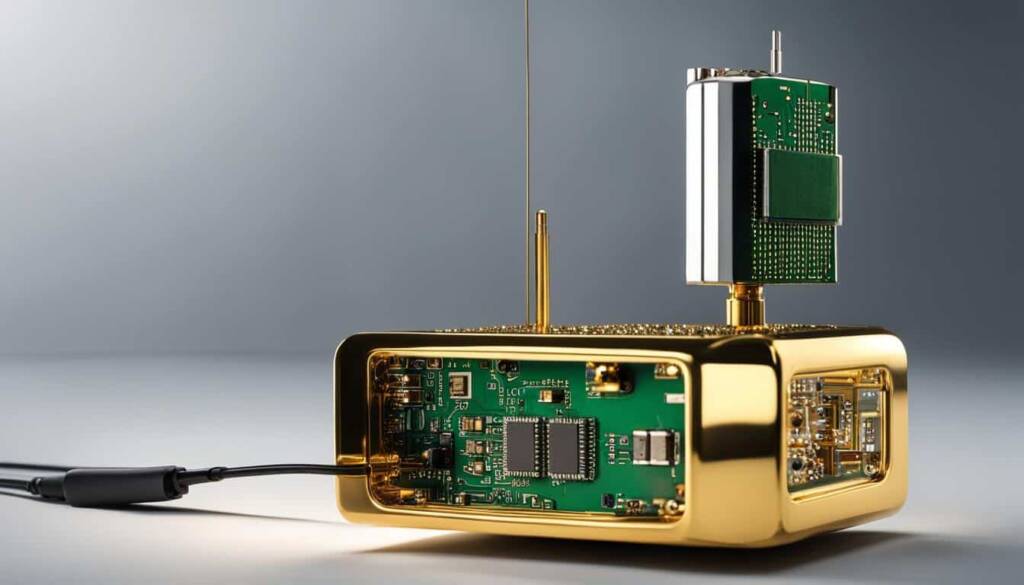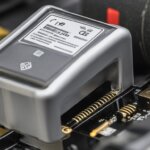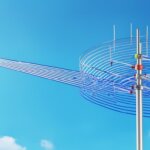Table of Contents
RFID (radio frequency identification) is a wireless communication technology that uses electromagnetic or electrostatic coupling to identify objects, animals, or people. It consists of three components: a scanning antenna, a transceiver, and a transponder. RFID tags, which contain an integrated circuit, an antenna, and a substrate, are used to encode identifying information.
There are two main types of RFID tags: active RFID tags with their own power source and passive RFID tags that receive power from the reader antenna. RFID systems operate at different frequencies, including low frequency (LF), high frequency (HF), and ultra-high frequency (UHF). The read range of RFID tags varies based on factors such as the type of tag, reader, and frequency.
RFID technology has various applications across industries, including asset tracking, inventory management, and access control.
How Does RFID Work?
RFID systems operate through the use of a scanning antenna, transceiver, and transponder. Let’s dive into the details of how this technology functions.
- The scanning antenna emits radio waves which serve to activate the RFID tags in the vicinity. The tags, also known as transponders, are equipped with an integrated circuit storing unique identifying information.
- Once activated, the RFID tag sends a wave back to the antenna. At this stage, the identifying information is transmitted from the tag’s integrated circuit to the antenna.
- The transponder is the main component within the RFID tag that receives the signals from the scanning antenna and facilitates communication with the RFID reader.
- RFID tags can be either read-only or read-write. Read-only tags contain fixed information which cannot be modified, whereas read-write tags provide the flexibility to add or overwrite data.
Factors Affecting RFID Read Range
The read range, or the distance at which an RFID tag can be scanned, is influenced by several factors, including:
- Tag Type: The design, size, and power of the RFID tag can impact its read range.
- Reader Type: The capabilities of the RFID reader, such as its power output and sensitivity, play a significant role in determining the read range.
- Frequency: Different RFID frequencies, such as low frequency (LF), high frequency (HF), ultra-high frequency (UHF), and microwave, have varying read ranges.
These factors work in tandem to determine the effective read range of RFID systems in different scenarios.
“RFID technology enables seamless communication between the scanning antenna and the RFID tag, allowing for quick and accurate data exchange.”
Visualizing RFID System Components
Here’s a visual representation of how the RFID system components interact:
| RFID System Component | Description |
|---|---|
| Scanning Antenna | The scanning antenna emits radio waves to activate RFID tags and captures the response from the tags. |
| Transceiver | Serves as the intermediary between the scanning antenna and the RFID reader. |
| Transponder | Located within the RFID tag, the transponder receives signals from the scanning antenna and responds accordingly, transmitting the tag’s identifying information. |
Types of RFID Systems
RFID systems can be categorized into different types based on their frequency ranges. These include Low Frequency (LF) RFID, High Frequency (HF) RFID, Ultra-High Frequency (UHF) RFID, and Microwave RFID.
Low Frequency (LF) RFID
LF RFID operates at frequencies ranging from 30 KHz to 500 KHz. These systems have shorter transmission ranges, usually within a few inches to less than six feet. LF RFID is commonly used for applications such as proximity access control and animal tracking.
High Frequency (HF) RFID
HF RFID operates at frequencies ranging from 3 MHz to 30 MHz. These systems have a range of a few inches to several feet. HF RFID is often used in applications like payment systems, identification cards, and library book tracking.
Ultra-High Frequency (UHF) RFID
UHF RFID operates at frequencies ranging from 300 MHz to 960 MHz. These systems have a read range of 25-plus feet, making them suitable for applications such as inventory management, supply chain tracking, and retail item tracking.
Microwave RFID
Microwave RFID operates at 2.45 GHz. These systems can be read from 30-plus feet away, making them ideal for applications requiring long-range identification and tracking, such as toll collection and vehicle tracking.
Each type of RFID system offers different benefits and has varying applications depending on the specific needs of businesses and industries.
Stay tuned for the next section, where we’ll explore the various applications and use cases of RFID technology.
RFID Applications and Use Cases
RFID technology has seen widespread adoption in various industries since the 1970s, thanks to decreasing costs and advancements in the technology. One of the most common applications of RFID is inventory tracking, which allows businesses to efficiently monitor and manage their stock levels. By tagging items with RFID tags, companies can easily track their inventory in real-time, reducing errors and improving overall efficiency.
Another key application of RFID is in supply chain management. RFID tags can be used to track products as they move through the supply chain, providing real-time visibility into their location and status. This enables companies to streamline their operations, improve logistics, and enhance customer satisfaction. With RFID technology, companies can optimize their supply chain processes, ensuring that products are delivered on time and in the right condition.
RFID technology is also widely used for asset tracking in various industries. By attaching RFID tags to assets such as equipment, vehicles, or tools, companies can easily locate and manage their assets. This helps prevent loss, theft, or misplacement of valuable assets, saving businesses time and money.
In addition to these primary applications, RFID technology has found its way into numerous other use cases. For example, passive RFID tags are commonly used for toll collection, allowing for convenient and seamless transactions. In libraries, RFID tags are used in books to simplify the borrowing and returning process. Access control systems also utilize RFID technology to enhance security and control entry to restricted areas. Moreover, RFID-enabled passports provide an efficient and secure method of identification for travelers.
While RFID technology offers numerous benefits, it is crucial to address security and privacy concerns associated with it. Unauthorized readers can potentially access RFID tag data, compromising personal information. To mitigate these risks, standards organizations regulate RFID technology, ensuring interoperability and compatibility among different systems.
Looking ahead, the future of RFID technology holds exciting possibilities. Its integration with the Internet of Things (IoT) is set to enable wireless transmission of sensor data, further enhancing its capabilities in data collection and analysis. As we continue to witness the widespread adoption of RFID and its continued advancements, it is clear that RFID technology will play a vital role in shaping the future of inventory tracking, supply chain management, and asset tracking.
FAQ
What is an RFID chip?
An RFID chip, or radio frequency identification chip, is a wireless communication technology that uses electromagnetic or electrostatic coupling to identify objects, animals, or people. It consists of three components: a scanning antenna, a transceiver, and a transponder.
How does RFID work?
RFID systems work by using a scanning antenna to transmit radio waves that activate the RFID tag, which then sends a wave back to the antenna. The RFID tag contains the identifying information stored in an integrated circuit. The read range of RFID tags can vary depending on factors such as tag type, reader type, and frequency.
What are the different types of RFID systems?
RFID systems can be categorized into different types based on their frequency ranges. These include low frequency (LF) RFID, high frequency (HF) RFID, ultra-high frequency (UHF) RFID, and microwave RFID. The choice of frequency depends on the specific RFID application.
What are the applications and use cases of RFID?
RFID technology is widely used in various industries for applications such as inventory tracking, supply chain management, and asset tracking. It is commonly used in healthcare, retail, manufacturing, and logistics. RFID provides benefits such as improved efficiency, real-time tracking, and accurate data management.













